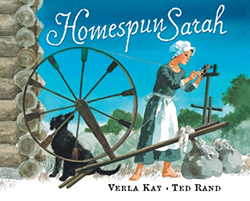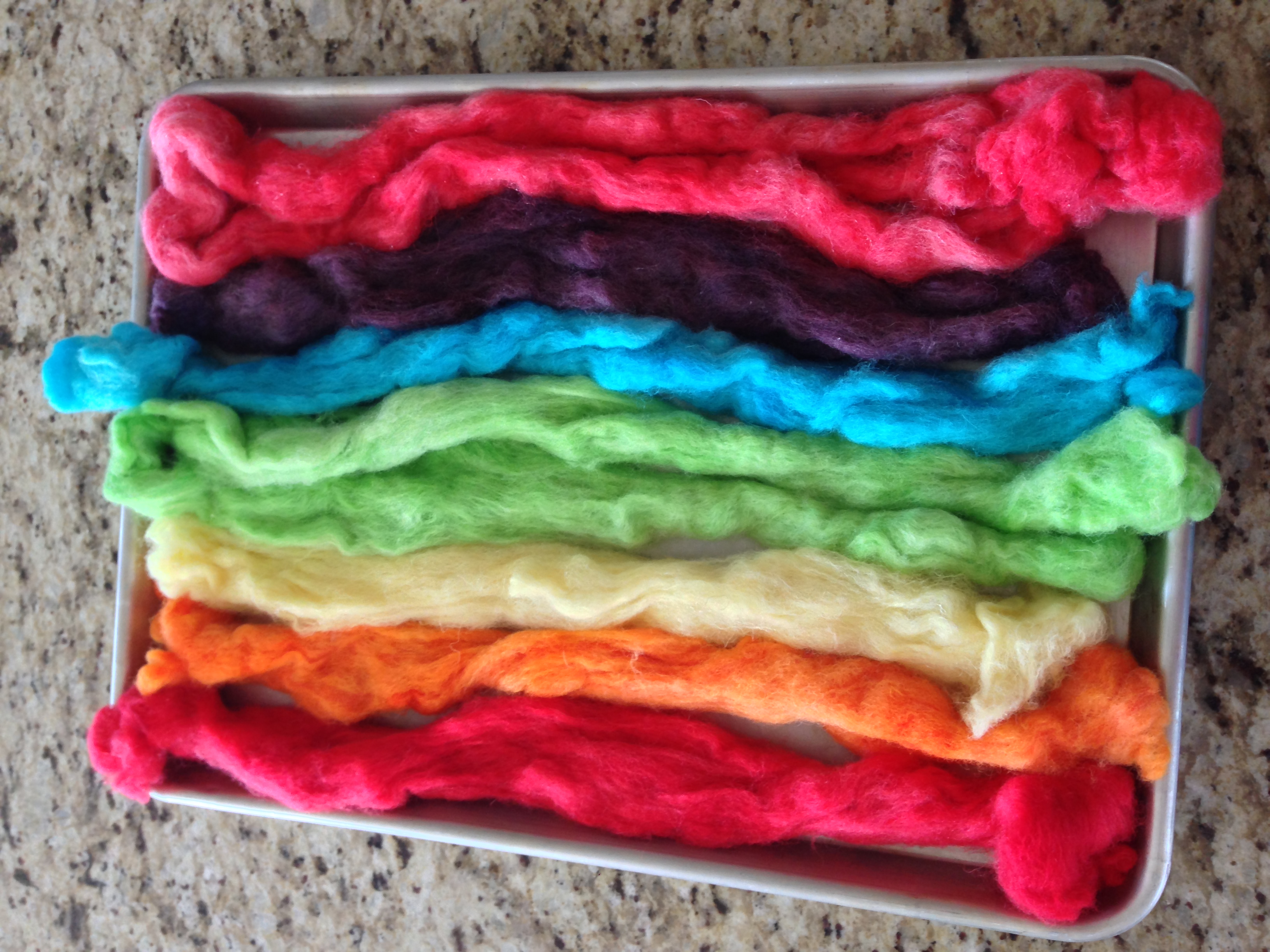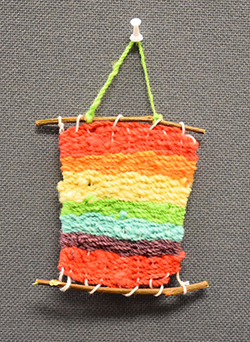 Relevancy and Engagement
ny.agclassroom.org
Relevancy and Engagement
ny.agclassroom.org
From Wool to Wheel
Grade Level
Purpose
Students investigate how the need for wool impacted the American colonists by examining the Wool Act of 1699, determining the importance of wool in colonial America, and comparing and contrasting the differences between processing wool then and now. Students spin, weave, and dye wool to explore how wool was processed in Colonial times. Grades 3-5
Estimated Time
Materials Needed
Engage:
- Homespun Sarah by Verla Kay
Supporting Question 1: What was the Wool Act of 1699?
- From Wool to Wheel Slideshow
- Where There's Wool, There's a Way Cards
- Where There's Wool, There's a Way video
Supporting Question 2: Why was wool so important to the colonists?
- From Wool to Wheel Slideshow
- Wool sample*
- Wool Observations and Properties activity sheet
- Sam the Lamb - Properties of Wool Video
*Wool Samples can be purchased from agclassroomstore.com
Supporting Question 3: How was wool processed in Colonial times?
- From Wool to Wheel Slideshow
- 18th Century Wool Production Video
- Woolen Mills Tour Video
- Wool: Then and Now Venn diagram, 1 per student
- Carded wool*
- Wool spinning hooks*
- Vinegar
- Glass bowl
- Microwave
- Kool-Aid
- Weaving Instructions
- Cardboard
- String
*Carded wool and spinning hooks can be purchased in a Wool Spinning Kit from agclassroomstore.com.
Vocabulary
carded: wool that has been cleaned, separated, and straightened out
drafting: the process of pulling out a fiber to be twisted
homespun: spun or woven in the home
lanolin: also called wool wax or wool grease, a wax found in the wool fibers of sheep
loom: a frame or machine for weaving threads or yarns to form cloth
patriotic: having or showing great love and support for one’s country
plying: twisting together two or more strands of fiber
shearing: removing fleece or hair by cutting or clipping
shed stick: a tool used to create a temporary separation between the warp yarns
warp: the set of lengthwise threads on a loom that are crossed at right angles by the weft
weft: thread or yarn which is drawn through the warp to create cloth
Did You Know?
- The four main products from sheep are lamb (meat from sheep younger than 14 months), mutton (meat from sheep older than 14 months), wool, and sheep’s milk.1
- Evidence has been found that wool cloth existed as far back as 10,000 B.C.1
- Christopher Columbus came from a family of wool traders. In the 15th century, Spain's thriving wool trade financed the expeditions of its conquistadors.1
- Merino sheep, which produce fine merino wool, were so valued in Spain that until the 18th century, exporting sheep was an offense punishable by death.1
- During World War I, President Woodrow Wilson had a flock of sheep trim the White House lawn.1
Background Agricultural Connections
|
From Wool to Wheel uses the College, Career, and Civic Life (C3) Framework's Inquiry Arc as a blueprint to lead students through an investigation of the importance of wool in Colonial America. The Inquiry Arc consists of four dimensions of informed inquiry in social studies:
The four dimensions of the C3 Framework center on the use of questions to spark curiosity, guide instruction, deepen investigations, acquire rigorous content, and apply knowledge and ideas in real world settings to become active and engaged citizens in the 21st century.2 For more information about the C3 Framework, visit socialstudies.org. C3 Table- Wool to Wheel |
Wool in Colonial America
Wool played an important role in Colonial America. Before the Revolutionary War, most of the finest textiles and fashionable styles were imported from Great Britain. Many colonists wanted to produce their own clothing and textile goods. Wool and linen were the most common materials used. Homespun clothes, clothes that were produced by the colonists, reduced the amount of clothing that had to be bought from England.
In 1699, under the rule of King William III, the British Parliament issued the Wool Act which prohibited American colonists from exporting wool or wool products outside of the colony in which it was produced. The king banned the export of sheep to the American colonies in an effort to protect England’s wool industry. Wool could only be imported into the colonies by Great Britain. The Wool Act was one of a series of taxes that divided Great Britain and its colonies in America.
The colonists began protesting the Wool Act by refusing to purchase or wear English textiles. Many colonists refused to purchase English goods. It became a patriotic act to wear American homespun clothing. George Washington, Thomas Jefferson, and Benjamin Franklin are notable figures who wore homespun clothing as a patriotic statement of their devotion to American independence and freedom. In the American colonies, spinning and weaving wool became a necessity and a patriotic duty.
In Colonial times, the process of making wool cloth began with shearing sheep in early spring with hand clippers. The wool was cleaned through a process called scouring in which the wool underwent a series of baths before it was laid out to dry.
Wool grease is produced as part of the wool’s growth and helps protect the sheep’s wool and skin from the environment. Scouring removes this grease from the wool. The grease can be captured from the scouring water. When it is refined, this grease is known as lanolin. Lanolin can be used in moisturizers, cosmetics, medicine, and industrial applications.
In preparation for spinning, wool must be carded. The colonists used hand carders to comb the wool, remove debris, and untangle the fibers, aligning them parallel with each other. Colonists used dye formulas that included insects, roots, flowers, nuts, seeds, tree bark, leaves, or berries. Because of the toxic chemistry, many of these colonial dyes have been deemed unsafe in our era. The dyeing process involved soaking wool in kettles of dye over fires for several hours.
Wool was spun into thread or yarn by tightly twisting the fibers using a spinning wheel. Weavers turned the wool thread into cloth using looms. Wool was also felted, a process of matting fibers together, to make products such as hats and slippers.
Engage
Compelling Question: How did the need for wool affect American colonists?
 Ask the students, "What happens when you grow out of your clothes?" After several students answer, explain that they are going to hear a story about a Colonial girl who grew out of her clothes.
Ask the students, "What happens when you grow out of your clothes?" After several students answer, explain that they are going to hear a story about a Colonial girl who grew out of her clothes.- Read the book Homespun Sarah by Verla Kay. Ask the students what happened when Sarah grew out of her clothes. Explain that, in Colonial times, many families raised their own sheep for wool that was used to make clothing and blankets.
- On the whiteboard or chart paper display the question, "How did the need for wool affect American colonists?" Explain to the students that they will be investigating this compelling question.
Explore and Explain
Supporting Question 1: What was the Wool Act of 1699?
- Explain to the students that wool played an important role in Colonial America. The colonists raised sheep and used their wool to produce yarn and cloth.
- Tell the students that the British King, King William III issued the Wool Act of 1699 to control the raising of sheep and the production of wool products in the colonies. Explain to the students that they will be investigating the question, "What was the Wool Act of 1699?"
- Use slides 2-5 from the From Wool to Wheel Slideshow to provide background information introducing the investigation of the Wool Act.
- Organize the students into groups of 3-4. Provide each group with a set of the numbered Where There's Wool, There's a Way question cards. Instruct the groups to lay the cards out in order from 1-12 and read each question together.
- Explain to the class that they are going to watch a video that will help answer the questions on the cards. Show the Where There's Wool. There's a Way video.
- After viewing the video, provide each group with a set of the Where There's Wool, There's a Way answer cards. Ask the groups to match the question cards with the correct answer cards.
- Revisit the question, "What was the Wool Act of 1699?" (The Wool Act prohibited American colonists from exporting wool and wool products outside of the colony in which it was produced. It also banned the export of sheep to the American colonies. The Wool Act was issued in an effort to protect England's wool industry, which was important to their economy. It resulted in anger, resentment, rebellion, and ultimately led to the American Revolution and the colonist's freedom from Britain.)
Supporting Question 2: Why was wool so important to the colonists?
- Explain to the students that they will investigate the question, "Why was wool so important to the colonists?"
- Go through slides 6-10 from the From Wool to Wheel Slideshow to share primary sources concerning the importance of wool in Colonial days.
- Have the students go back to their groups from Supporting Question 1. Provide each group with a sample of wool and the Wool Observations and Properties activity sheet.
- Ask the groups to observe the wool sample and write their observations on the activity sheet.
- Show the Sam the Lamb—Properties of Wool video. Instruct the groups to add the properties of wool to the activity sheet.
- Discuss the observations and properties the groups included on their activity sheets:
- Wrinkle-resistant: At a microscopic level, each wool fiber is like a coiled spring that returns to its natural shape after being bent. This gives wool clothes a natural wrinkle resistance.
- Elastic: Natural elasticity helps wool clothes stretch with your body before returning to their original shape. Fine wool clothing is ideal when exercising.
- Soft: Wool fibers are extremely fine, allowing them to bend and feel soft and gentle next to your skin.
- Warm and Cool: Wool is an active fiber that reacts to changes in body temperature. It helps you stay warm when the weather is cold and cool when the weather is hot. Because wool helps regulate your temperature, a wool blanket may help you sleep well.
- Fire-resistant: Wool is flame retardant, doesn't melt or stick to your skin, and even self-extinguishes when the source of the flame is removed.
- Odor-resistant: Wool can absorb moisture vapor, which means less sweat on your body. It even absorbs and locks away the odors from sweat, which is then released during washing.
- Stain-resistant: Wool fibers have a natural protective outer layer that prevents stains from being absorbed.
- Sun Safe: Wool protects the skin from UV radiation.
- Natural: Wool is grown year-round. After a sheep is shorn, it begins growing new wool. Wool a renewable fiber source. Most sheep are shorn at least once a year.
- Biodegradable: Wool will naturally decompose in soil.
- Revisit the question, "Why was wool so important to the American colonists?" (Wool clothing was necessary to survive the cold harsh winters. Being able to raise their own sheep and spin and weave their own cloth allowed the colonists to not only produce clothing and wool products for themselves, but also to trade and import their wool products.)
Supporting Question 3: How was wool processed in Colonial times?
- Explain to the students that they will investigate the question, "How was wool processed in Colonial times?"
- Go through slides 11-18 from the From Wool to Wheel Slideshow to show how wool was processed in Colonial days.
- Lead a discussion with the students about the continued importance of wool today. Explain that they will be viewing two short movies about how wool cloth was made in Colonial times and how it is made today.
- Show the students the 18th Century Wool Production and Woolen Mills Tour videos. While viewing the videos, ask the students to use the Wool: Then and Now Venn diagram to list similarities and differences between how wool was processed in Colonial times and how wool cloth is made today.
- As a class compare and contrast the processes used then and now for shearing, cleaning, carding, dyeing, spinning, and weaving wool.
- Discuss the modern advances in technology that allow for more efficient wool processing.
- Explain to the students that they will have an opportunity to dye, spin, and weave wool. As they follow the instructions below, discuss how the processes and tools they are using compare with the way wool was dyed, spun, and woven in Colonial times.
- Dyeing Wool
- In a glass bowl, combine 1 package of Kool-Aid, 1 cup of water, and 1 tablespoon of vinegar. Stir until the Kool-Aid completely dissolves.
- Completely immerse an arm’s length of wool into the Kool-Aid mixture.
- Place the bowl of wool and Kool-Aid mixture into a microwave. Heat on high for two minutes.
- Remove the bowl from the microwave and allow to cool. BE CAREFUL; IT’S HOT!
- After the mixture has cooled, rinse the wool in cold water and allow to dry.
- Spinning Wool
- Give each student a piece of wool approximately 1/4" wide and 14" long. Fold about 1/2" of wool over the end of the spinning hook and begin spinning.
- Back your non-spinning hand out as the wool is spun; this is called drafting.
- Draft out the wool so that the spun wool is taut, but not “bumpy.” If you get twisted bumps in your spun yarn, draft (or let out) more unspun wool. When you have twisted the entire length of the wool, don’t let go—it will unspin. You are now ready to ply your yarn.
- Plying the yarn will keep it from unspinning and make it stronger. Plying is the twisting together of two single strands of spun wool. Have someone hold the center of the twisted wool while you hold the ends.
- Bring the ends of the wool together in one hand so that there are two strands side-by-side. Have your helper let go, and let the wool twist together. It should spring into a twisted strand. The double strand is now called plied yarn.
- Note: You can view a demonstration of the wool spinning process here.
- Weaving Wool

- Note: Refer to the Weaving Instructions guide to view photographs of each step of the weaving process.
- Cut a rectangular piece of cardboard to your desired size. We used a 5" x 5" piece. This will become your loom.
- Use scissors to cut 1/4"-slits 1/2" apart along two opposite ends of the cardboard.
- To create the warp on the loom, tape one end of the string to the back of the cardboard. Then string it through the first notch, around the front of the cardboard piece from top to bottom and into the opposite notch. Continue until all of the notches have been filled. Tape the second end of the string to the back of the cardboard.
- Tie several strands of the spun and plied wool from step three together to make one long piece.
- Use the spinning hook from the wool spinning kit as your shed stick. A shed stick is a tool used to create a temporary separation between the warp yarns. Feed the shed
stick over and under the warp with every second string being raised. - Weave the yarn across the loom following the pattern of the shed stick. This yarn is known as the weft. To weave the second row, feed the shed stick in the opposite over under pattern from the previous row and follow the pattern with the yarn. Use the shed stick to gently push each row together. Repeat this process until the weaving is finished.
- When the weaving is finished, insert a twig or dowel above and below the woven piece.
- Detach the string from the cardboard notches and tie the loose ends to the twigs. An extra piece of yarn can be tied to the top twig for hanging.
- Revisit the question, "How was wool processed in Colonial times?" (Sheep were sheared with hand clippers. The wool was cleaned through a process called scouring, carded, dyed, spun into thread or yarn on a spinning wheel, and woven into cloth using a loom.)
This lesson investigates the impact of wool on early U.S. history. If you teach in the following states, refer to your local agricultural literacy resources about wool:
Evaluate
Summative Performance Task
Using evidence from historical sources, construct an argument (e.g., essay, project, video production, portfolio, detailed outline, poster) that addresses the compelling question, "How did the need for wool impact American colonists?"
Elaborate
-
Taking Informed Action
- Understand: Identify a group of people who are currently trying to revolutionize some aspect of society (political, economic, social, technological, etc.).
- Assess: Examine whether the revolution has been successful.
- Act: Write a newspaper editorial stating your personal stance on whether the revolution is justified.
Sources
- http://www.pbs.org/pov/sweetgrass/sheep-facts/
- https://www.asanet.org/sites/default/files/savvy/documents/students/docs/FINAL%20C3%20Fact%20Sheet%209-13-13-1.pdf
Recommended Companion Resources
- America's Heartland: Bachelor Sheep Ranch
- America's Heartland: Wild & Wooly Roundup
- Charlie Needs a Cloak
- From Fiber to Fabric... Wool's a Natural
- Hands-On With Wool
- Homespun Sarah
- How It's Made: Wool
- If You Lived In Colonial Times
- If You Want to Knit Some Mittens
- Sheep 101
- Sheepology: The Ultimate Encyclopedia
- The Surprise
- Tuttle's Red Barn: The Story of America's Oldest Family Farm
- Unraveling Fibers
- Weaving the Rainbow
- Where Did My Clothes Come From?
- Wild Rose's Weaving
- Wool Ewe Keep Me Warm? Video
- Wool Samples
- Wool Spinning Kit

